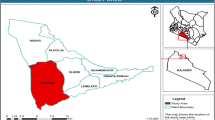Abstract
In the framework of a nature conservation project in a wetland region of Meetkerke, Belgium, a comprehensive study was conducted to analyse and to compare species composition and diversity among wet grasslands under the six following types of agricultural land use: pastures used at high or low stocking rate, hayfields used at high or low mowing frequency, abandoned hayfields and hay pastures. The focus of the study was on the effects of grassland management on species diversity and on the restriction of occurrence of invasive clonal species. The results show that species importance was strongly related to grassland exploitation parameters and soil hydrological parameters, as shown by the ordination diagram drawn by canonical correspondence analysis (CCA). Species number and importance of non-leguminous dicotyledons were negatively correlated to intensity of use, N supply, water table depth and soil drainage. Phalaris arundinacea, an invasive species which might reduce species diversity, was better suppressed in grazed grassland than in mown grassland. Phalaris arundinacea and Cirsium arvense were most prevalent in abandoned hayfields. Grazing at low stocking rate was the best management technique to maximise plant diversity while restricting invasion by nitrophilous clonal species. Although species-rich and of high complementary value on a landscape scale, haylands mown at low frequency are at higher risk of invasion by clonal species.
Similar content being viewed by others
References
Andresen H., Bakker J.P., Brongers M., Heydeman B., Irmler U. (1990) Long-term changes of salt marsh communities by cattle grazing, Vegetatio 89, 137–148.
Boose A.B., Holt J.S. (1999) Environmental effects on asexual reproduction in Arundo donax, Weed Res. 39, 117–127.
Brinson M.M., Malvarez A.I. (2002) Temperate freshwater wetlands: types, status, and threats, Environ. Conserv. 29, 115–133.
De Vries D.M. (1948) Method and survey of the characterization of Dutch grasslands, Vegetatio 1, 51–57.
Duelli P., Obrist M.K. (2003) Biodiversity indicators; the choice of values and measures, Agr. Ecosyst. Environ. 98, 87–98.
Esselink P., Zijlstra W., Dijkema K.S., van Diggelen R. (2000) The effects of decreased management on plant-species distribution patterns in a salt marsh nature reserve in the Wadden Sea, Biol. Conserv. 93, 61–76.
Food and Agricultural Organization (FAO) (1989) The world reference base for soil resources. World Soil Resources Reports 84. ISS/AISS/IBG/ISRIC/FAO, Rome, Italy.
Galatowitsch S.M., Whited D.C., Lehtinen R., Husceth J., Schik K. (2000) The vegetations of wet meadows in relation to their landuse, Environ. Monit. Assess. 60, 121–144.
Gosselink J.G., Turner R.E. (1978) The role of hydrology in freshwater wetland ecosystems, in: Good R.E., Whigham D.F., Simpson R.L. (Eds.), Freshwater Wetlands: Ecological Processes and Management Potential, Academic Press, New York, pp. 63–78.
Grace J.P., Smith M.D., Grace S.L., Collins S.L., Stohlgren T.J. (2001) Interactions between fire and invasive plants in temperate grasslands of North America, in: Galley K.E.M., Wilson T.P. (Eds.), Proceedings of the Invasive Species Workshop: The Role of Fire in the Control and Spread of Invasive Species, Fire Conference 2000, Tall Timbers Research Station, Tallahassee, Miscellaneous Publication, Vol. 11, pp. 40–65.
Grekul C.W (2003) Canada Thistle Control in Pasture, M.S. thesis, University of Alberta, 166 p.
Heger T., Ludwig T. (2003) Predicting biological invasions, Biol. Invas. 5, 313–321.
Hobbs R.J., Humphries S.E. (1995) An integrated approach to the ecology and management of plant invasions, Conserv. Biol. 9, 761–770.
Houlahan J.E., Findlay C.S. (2004) Effect of invasive plant species on temperate wetland plant diversity, Conserv. Biol. 18, 1132–1138.
Jacquemyn H., Brys R., Hermy M. (2003) Short-term effects of different management regimes on the response of calcareous grassland vegetation to increased nitrogen, Biol. Conserv. 111, 127–138.
Jongman R.H., ter Braak C.F.J., van Tongeren O.F.R. (1995) Data Analysis in Community and Landscape Ecology, Cambridge University Press, UK, 299 p.
Kahmen S., Poschlod P. (2004) Plant functional trait responses to grassland succession over 25 years, J. Veg. Sci. 15, 21–32.
Kolb A., Alpert P., Enters D., Holzopfel C. (2002) Patterns of invasion within a grassland community, J. Ecol. 90, 871–881.
Lambrecht-McDowell S.C., Radosevich S.R. (2005) Population demographics and trade-offs to reproduction of an invasive and non invasive species of Rubus, Biol. Invas. 7, 281–295.
Nuzzo V. (1997) Element Stewardship Abstract for Cirsium arvense, The Nature Conservancy, Arlington, VA.
Paine L.K., Ribic C.A. (2002) Comparison of riparian plant communities under four land management systems in southwestern Wisconsin, Agr. Ecosyst. Environ. 92, 93–105.
Pykälä J. (2005) Plant species responses to cattle grazing in mesic semi-natural grassland, Agr. Ecosyst. Environ. 108, 109–117.
Raven P.J. (1986) Vegetation changes within the flood relief stage of two-stage channels excavated along a small rural clay river, J. Appl. Ecol. 23, 1001–1011.
Schooler S.S., McEvoy P.B., Coombs E.M. (2006) Negative per capita effects of purple loosestrife and reed canary grass on plant diversity of wetland communities, Div. Distr. 12, 351–363.
Spence D.H.N. (1982) The zonation of plants in freshwater lakes, Adv. Ecol. Res. 12, 37–125.
Stachion W.J., Zimdahl R.L. (1980) Allelopathic activity of Canada thistle (Cirsium arvense) in Colorado, Weed Sci. 28, 86–93.
Thompson J.R., Finlayson C.M. (2001) Freshwater wetlands, in: Warren A., French J.R. (Eds.), Habitat Conservation: Managing the Physical Environment, John Wiley and Sons Ltd, Chichester, pp. 147–178.
van der Meijden R. (2005) Heukels’ Flora of the Netherlands, Wolters-Noordhoff, Groningen, the Netherlands (in Dutch).
VLM (2002) Natuurinrichting project Meetkerkse Moeren, Projectrapport, Vlaamse Landmaatschappij, Aminal Afdeling Natuur, 116 p. (in Dutch).
Weyand A. (2005) Drivers of Grassland Biodiversity in the Swiss Alps, Doctoral thesis University of Zürich, 141 p.
Williamson M. (1996) Biological Invasions, Chapman & Hall, London, UK.
Author information
Authors and Affiliations
Corresponding author
About this article
Cite this article
De Cauwer, B., Reheul, D. Impact of land use on vegetation composition, diversity and potentially invasive, nitrophilous clonal species in a wetland region in Flanders. Agron. Sustain. Dev. 29, 277–285 (2009). https://doi.org/10.1051/agro:2008049
Accepted:
Issue Date:
DOI: https://doi.org/10.1051/agro:2008049




